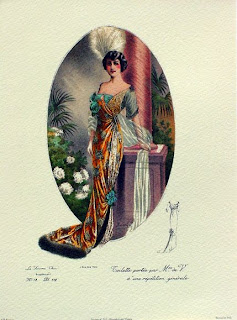 By Lisa Marie Wilkinson
By Lisa Marie WilkinsonThe 1890-1914 period referred to as La Belle Époque (French for “Beautiful Era”) was a time of peace and national pride buoyed by scientific and technological discovery. This fashion era overlapped the Edwardian fashion era in Britain and is nostalgically viewed as a golden age in contrast to the stark world introduced by World War I.
In France, those of wealth and privilege enjoyed the perks only the rich could afford, frequenting new entertainments such as the Folies Bergere, the Moulin Rouge and flocking to view the new Eiffel Tower, which was constructed as a grand entrance to the 1889 World’s Fair.
While men’s fashion did not undergo significant change during this period, women’s fashion saw the gradual disappearance of the bustle, replaced by a new, slimmer silhouette featuring enormous leg of mutton sleeves and tapered waists framed by sashes or belts flowing into trumpet-bell shaped skirts. This slender profile was offset by huge, ostentatious hats named “Merry Widows” after the popular operetta of the time. These accessories featured feathers and lavish trims (including stuffed hummingbirds for those who could afford them).
The descriptive term that easily captures this fashion era is the “pouter pigeon,” a corseted look with the bust suppressed into a “monobosom.” Fashion accents included gloves made of silk, suede or kid leather that were worn outdoors in summer and winter and featured frilly parasols dripping lace.
In Britain, the renowned tailoring houses of Redfern and Creed applied their skills to tailored fashions for women, creating ready to wear wool or serge suits paired with shirtwaist blouses and simple gored skirts and matching jackets promoted as ideal for traveling. This tailored look was embraced by middle class women entering the workforce, and was often criticized as masculine in appearance as women began to sport neckware rivaling that of their male counterparts.
 The severity of the tailored suit was relieved by feminine touches such as ornate blouses embellished by embroidery, ruffled jabots decorated by stick pins, and collars reaching under the chin that were held in place by silk-wrapped wires to create the impression of an elongated neck.
The severity of the tailored suit was relieved by feminine touches such as ornate blouses embellished by embroidery, ruffled jabots decorated by stick pins, and collars reaching under the chin that were held in place by silk-wrapped wires to create the impression of an elongated neck.The high-necked collar mandated for day wear was replaced by low sweetheart, round, or square necklines for evening fashions designed to showcase the owner’s jewelry. A lady dressed for an evening’s entertainment outside the home was not encumbered by what do to with her handbag. Little or no money was carried because purchases were charged to accounts and so little makeup was worn that only a dainty bag attached by a wrist strap was needed to complete her ensemble.
 |
| Gibson Girl by Charles Dana Gibson |
Lisa Marie Wilkinson is an IPPY Gold Medal winning author of historical adventure-romance. Her latest novel, STOLEN PROMISE, featuring vibrant Gypsy characters and breath-taking romance, is available now.

